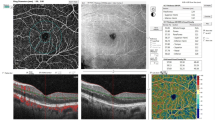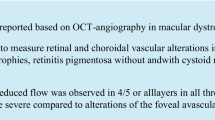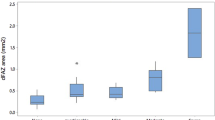Abstract
Objectives: To evaluate the use of Optical Coherence Tomography (OCT) in the diagnosis of macular edema (ME) in diabetic patients in comparison to indirect ophthalmoscopy (IO) and, in addition, to study the characteristics of these patients. Methods: 165 patients were randomly selected to join the study in 1998. Ophthalmological, clinical and laboratory examinations were performed for all these patients. Results: Diabetic retinopathy was identified in 143 eyes (44.7%) and ME in 58 (18.3% of the total and40.5% of the patients with retinopathy). 82.7% (48) of the eyes with ME could be diagnosed with OCT, against 62.0% (36) with IO. Haemoglobin A1c was the only variable that showed a significant association with ME, when compared to control (p < 0.05). Retinopathy was associated with the presence of nephropathy (p = 0.01) and neuropathy (p = 0.001), but ME was not (NS for both). 68% of patients without ME had a visual acuity of more than 50%. Conclusions: OCT is a new method that can help the evaluation of ME in diabetic patients. It can be used not only to diagnose the lesion, but also to follow up the patients during treatment. High levels of haemoglobin A1cmight be associated with the presence of ME. Diabetic complications (nephropathyand neuropathy) are associated with retinopathy but not with macular edema.
Similar content being viewed by others
References
Klein R, Klein BEK, Moss SE, Davis MD, DeMets DL. The Wisconsin epidemiologic study of diabetic retinopathy II. Prevalence and risk of diabetic retinopathy when age at diagnosis is less than 30 years. Arch Ophthalmol 1984; 102: 520–526.
Diabetes Control and Complication Trial Research Group. The effect of intensive treatment of diabetes on the development and progression of long-term complications in insulin-dependent diabetes mellitus. N Engl J Med 1993; 329: 977–986.
Klein R, Klein BEK, Moss SE. Visual impairment in diabetes. Ophthalmology 1984; 91(1): 1–9.
Bursell SE, Clermont AC, Kinsley BT, Simonson DC, Alello LM, Wolpert HA. Retinal blood flow changes in patients with insulin-dependent diabetes mellitus and no Diabetic retinopathy. Invest Ophthalmol. Vis Sci 1996; 37(5): 886–897.
Klein R, Klein BEK, Moss SE, Cruickshanks KJ. TheWisconsin epidemiologic study of diabetic retinopathy XV. The long term incidence of macular edema. Ophthalmology 1995; 102: 7–16.
Javitt JC, Canner JK, Sommer A. Cost effectiveness of current approaches to the control of retinopathy in type I diabetics. Ophthalmology 1989; 96: 255–264.
Early Treatment Diabetic retinopathy Study Research Group. Early photocoagulation for diabetic retinopathy: ETDRS report no 9. Ophthalmology 1991; 98: 766–785.
American Diabetes Association. Diabetic Retinopathy. Diabetes Care 1998; 21(1): 157–160.
Hee MR; Izatt JA; Swanson EA, Huang D, Schuman JS, Lin CP et al. Optical coherence tomography of the human retina. Arch Ophthalmol 1995; 113(3): 325–332.
Huang D, Swanson EA, Lin CP, Schuman JS, Stinson WG, Chang W, et al. Optical coherence tomography. Science 1991; 254: 1178–1181.
Hee MR, Baumal CR, Puliafito CA, Duker JS, Reichel E, Wilkins JR, et al. Optical coherence tomography of age-related macular degeneration and choroidal neovascularization. Ophthalmology 1996; 103(8): 1260–1270.
Ajello LP, Gardner TW, King GL, Blankenship G, Cavallerano JD, Ferris FL et al. Diabetic retinopathy. Diabetes Care 1998; 21(1): 143–156.
Hee MR, Puliafito CA, Wong C, Duker JS, Reichel E, Rutledge B, et al. Quantitative assessment of macular edema with optical coherence tomography. Arch Ophthalmol 1995; 113: 1019–1029.
Imai M; Iijima H; Gotoh T; Tsukahara S. Optical coherence tomography of successfully repaired idiopathic macular holes. Am J Ophthalmol 1999; 128(5); 621–627
Otani T, Kishi S, Maruyana Y. Patterns of diabetic macular edema with optical coherence tomography. Am J Ophthalmol 1999; 127(6): 688–693.
Lloyd CE, Matthews KA, Wing RR, Orcherd TJ. Psychological factors and complications of IDDM, The Pittsburgh epidemiology of diabetes complications study. VIII. Diabetes Care 1992; 15(2): 166–173.
Author information
Authors and Affiliations
Rights and permissions
About this article
Cite this article
Moreira, R.O., Trujillo, F.R., Meirelles, R.M. et al. Use of Optical Coherence Tomography (OCT) and Indirect Ophthalmoscopy in the Diagnosis of Macular Edema in Diabetic Patients. Int Ophthalmol 24, 331–336 (2001). https://doi.org/10.1023/B:INTE.0000006784.52885.e9
Issue Date:
DOI: https://doi.org/10.1023/B:INTE.0000006784.52885.e9




